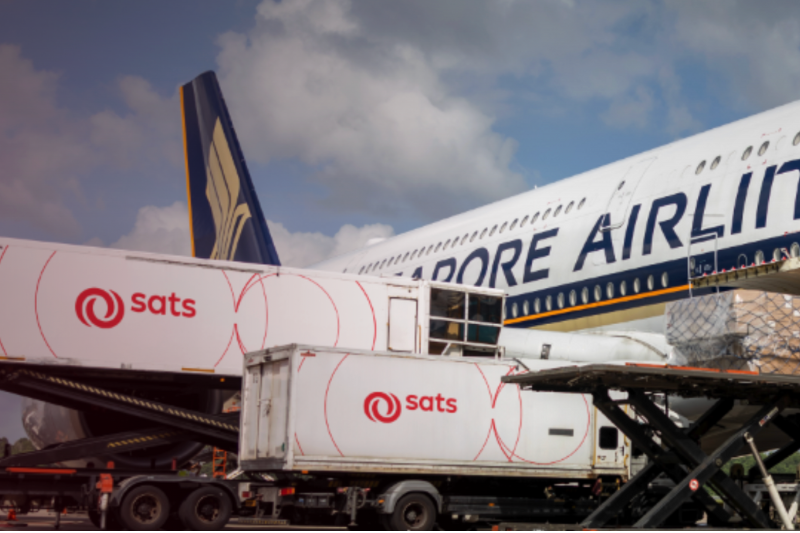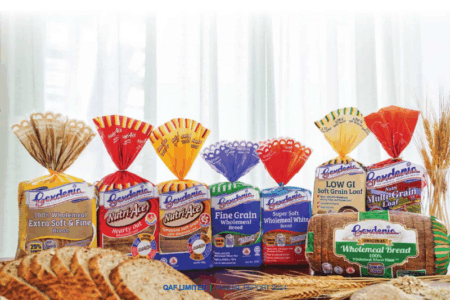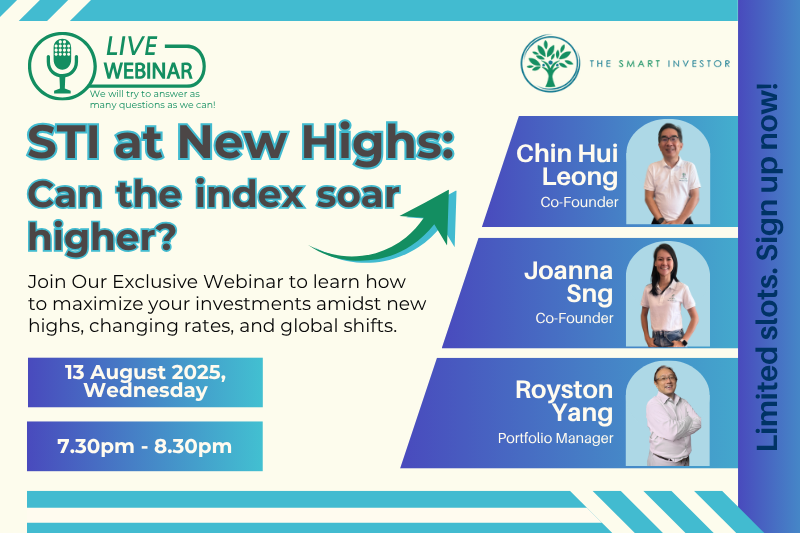“Do you know the only thing that gives me pleasure? It’s to see my dividends coming in.” This quote, by American business magnate John D. Rockefeller, surely resonates with income investors whenever they receive dividend payouts.
Indeed, 2025 is shaping up to be a rewarding year for such investors, as some of Singapore’s biggest blue-chip companies have raised their dividends amid stronger earnings and improving economic conditions.
With a number of central banks cutting interest rates this year, the dividend yields these stocks offer will become relatively more attractive, and should sustain share prices going forward – if their dividends are maintained.
Here are five blue-chip stocks — SATS (SGX: S58), Singapore Exchange (SGX: S68), DBS Group Holdings (SGX: D05), ST Engineering (SGX: S63), and CapitaLand Integrated Commercial Trust (SGX: C38U) — that have rewarded shareholders with higher payouts this year.
We also consider how they could continue to deliver dependable income ahead.
SATS — Reinstating Growth and Restoring Dividends
Air cargo handler and airline caterer SATS paused paying dividends during the pandemic.
However, the recovery in its business since then have sent its earnings – and dividend payouts – soaring.
This has been aided by the acquisition of Worldwide Flight Services (WFS) in April 2023, which initially drew a mixed response from analysts.
However, apart from being financially accretive, the acquisition also enabled SATS to become the largest air cargo handler in the world.
Revenue in its financial year ending March 2025 (FY2025) rose 13% year-on-year to S$5.8 billion, while profit after tax climbed 4x to S$261 million.
This enabled the company to raise its dividend for the period to S$0.05 per share, a 233% increase from the previous year.
Despite this, SATS’s dividend payout ratio declined from 39.7% in FY2024 to 30.5% in FY2025.
The company is also highly cash generative, with cash flow from operations in FY2025 of S$1.1 billion.
This was more than enough to cover its dividend payments for the year, as well as pay down debt, resulting in its debt-to-equity ratio falling from 1.60 in FY2024 to 1.53.
Looking ahead, catalysts for SATS include increased regional demand for aviation meals and recent contract-wins from the likes of Cathay Cargo and Emirates SkyCargo.
This should lead to better profitability, stronger cash flows, and a rising dividend.
Singapore Exchange — A Quiet Dividend Compounder
In 2009, SGX cut its dividend by over 30%. This was understandable, given the turmoil financial markets faced then during the Great Financial Crisis.
However, the company has since either maintained or grown its dividend.
In its financial year ending June 2025 (FY2025), SGX’s dividend was S0.375 per share, 9% higher than the year before, and nearly equaling the record S$0.38 per share dividend for FY2008.
The growing dividend is backed by SGX’s diverse, cash-generating mix of businesses. Its top line in FY2025 was S$1.3 billion, and comprised Fixed Income, Currencies and Commodities (25%), Equities – Cash (30%), Equities – Derivatives (27%), and Platform and Others (18%).
It’s important to note that SGX’s dividend is sustainable. The dividend payout ratio was 61.9% in FY2025, while the company’s cash flow from operations covered the dividend by 2.1x.
SGX expects to achieve revenue growth of 6% to 8% in the medium term, fueled by the expansion of its over-the-counter FX platform, as well as the strengthening of its products across asset classes and geographies.
This will support an increasing dividend, which SGX expects to increase steadily at the rate of S$0.0025 per share every quarter between FY2026 and FY2028.
DBS Group Holdings — Banking on Bigger Payouts
DBS, the Singapore stock market’s largest company by market capitalisation, has achieved record levels of profit in recent years while maintaining capital strength, supported by both rising net interest income and fee-related income.
To reward shareholders, DBS has been hiking dividends, buying back shares, and even distributing bonus shares.
In the first nine months of 2025 (9M 2025), DBS paid out S$2.25 in dividends per share (comprising S$1.80 per share in ordinary dividends and S$0.45 per share in capital return), 39% higher than the same period last year.
This hike came despite a 1.0% decline in 9M 2025 net profit, which was mainly due to falling net interest income and rising expenses.
But notably, DBS’s fee income alone increased by S$599 million (19% higher from a year ago), more than offsetting the S$310 million decrease in net interest income.
The bank’s return on equity for the 9M 2025 was 17.0%, which are noticeably higher than those of its peers, OCBC (12.9%) and UOB (9.0%), for the same period.
For 2026, DBS is forecasting total income to be around the same level as this year, despite the prospect of lower net interest income as a result of rate cuts.
This is because the bank expects to see high-single digit growth in its commercial book non-interest income, powered by mid-teens growth in wealth management income.
This should support continued growth in DBS’s returns to shareholders, including through higher dividends.
ST Engineering — Reliable Payouts From a Resilient Order Book
ST Engineering, which is in the technology, defence, and engineering sectors, distributed S$0.08 per share in dividends to shareholders in the first half of 2025 (H1 2025), the same amount as in H1 2024. This follows an increase of 6% in the dividend per share between 2023 and 2024.
The company won S$9.1 billion in orders in H1 2025, which gave it a total order book of S$31.2 billion as at June 2025, providing investors with visibility into its financial performance and ability to pay out dividends over the next few years.
For H1 2025, revenue was S$5.9 billion, a 7% year-on-year increase. 45% of ST Engineering’s revenue came from its Defense and Public Security segment, 40% from Commercial Aerospace, and the balance from Urban Solutions.
Meanwhile, net profit of S$403 million was 20% higher year-on-year.
ST Engineering generated S$761 million in cash flow from operations in H1 2025, which was enough to cover the $249 million in cash required to pay the dividend of S$0.08 per share for the period.
The company has also been reducing its debt in recent years, with its gross debt / last-twelve months EBITDA ratio falling from 5.2x as at December 2022 to 3.2x by June 2025.
Analysts expect ST Engineering’s growth over the next three years to come from its Commercial Aerospace and Defense and Public Security segments, while the Commercial Aerospace and Urban Solutions segments should also see wider operating margins. If so, shareholders could be rewarded by higher dividends.
CapitaLand Integrated Commercial Trust — REIT Resilience Rewarding Investors
CICT hiked its distribution per unit (DPU) by 3.5% to S$0.0562 in the H1 2025, supported by a 12.4% rise in distributable income to S$412 million, which in turn benefitted from a lower average cost of debt, as interest rates came down.
Singapore’s first real estate investment trust (REIT) owns a portfolio of prime retail and office assets in Singapore, including Grade A office building CapitaSpring, luxury mall ION Orchard, and the landmark integrated development Raffles City.
The REIT maintained a high occupancy rate in H1 2025 (96.3%) and achieved strong rental reversions of 7.7% for its retail portfolio and 4.8% for its office portfolio. Meanwhile, its aggregate leverage was a healthy 37.9%, 0.6 percentage points lower compared to December 2024.
Looking ahead, CICT’s DPU could grow through a combination of lower interest expenses and higher income, with the completion of ongoing-asset enhancement initiatives for properties such as Lot One Shoppers’ Mall and Tampines Mall.
What Rising Dividends Tell Investors
No matter the industry – finance, industrials, infrastructure, and REITs – rising dividends reflect management’s confidence in their ability to grow earnings.
Apart from receiving regular payments, investors in companies that regularly hike their dividends often benefit from superior share price gains, too.
These blue-chips combine reliable, growing payouts with the potential for share price appreciation, making them suitable for both income and growth investors.
Get Smart: Slow and steady increases compound
While some may view paying dividends as something a company does when it has run out of better alternatives for deploying capital, they are in fact the ultimate proof of a company’s strength, and impose discipline on management.
Of course, investors shouldn’t just chase the stocks that offer the highest dividend yields, especially if these are unsustainable.
However, if they spend time looking for businesses that are in a position to keep raising payouts, which are adequately covered by rising earnings and cash flow, they may find themselves richly rewarded over time.
Don’t let market uncertainty hijack your financial dreams. While headlines scream gloom, 5 Singapore companies have been quietly building wealth and paying reliable dividends. You’re probably overlooking them. Discover these resilient giants and their secrets to sustained income, even through global storms. Click here to download your free report now and secure your financial future!
Follow us on Facebook, Instagram and Telegram for the latest investing news and analyses!
Disclosure: Silas owns shares in DBS and CICT.





